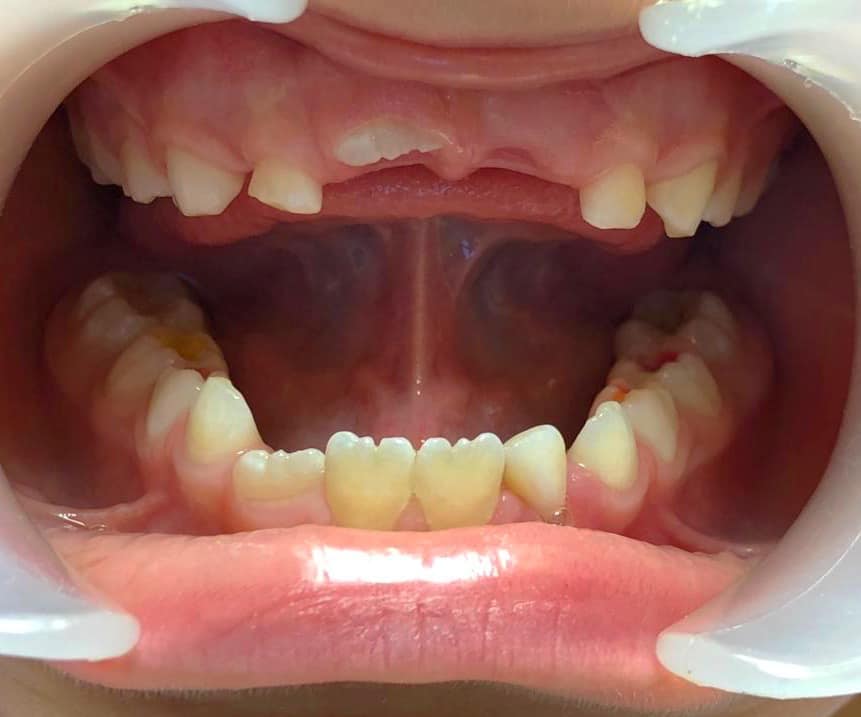Prevention for children – developing healthy habits
Dentysta stomatolog Warszawa Ursynów ADENTIS / Information and advice / Orthodontic advice / Prevention for children – developing healthy habits

Prevention for children – developing healthy habits
Prevention of malocclusions, speech defects and posture defects.
Epidemic of malocclusion and posture
THE POWER of proper chewing and breathing.
Developing good habits is the goal of functional orthodontics! Health is a game of strategy – start small and basic. Proper eating and breathing has great POWER
This is the rehabilitation of the masticatory system every day and every minute. Our little ones need support. Health is a dynamic thing, there is no guarantee of health if we do not take care of it ourselves. The orthodontist does not need to know strategically how to deal with the patient’s muscles during dental rehabilitation, but he should be able to diagnose abnormalities and refer the patient to the appropriate specialist.
Chewing is a physical activity that must be learned from an early age. Just like we learn to speak and write. We need to learn to chew properly. Chewing is very important for the child’s physical and mental development and the proper development of the jaw. A delay in the development of this function may occur due to incorrect eating habits, e.g. a mushy diet, using a bottle instead of a spoon for too long, a small supply of solid and hard food. Attention, children are great at manipulating and forcing their preferred industrially processed foods. Incorrect habits such as using pacifiers and finger sucking also affect the abnormal development of the facial skeleton. More and more often, children come to my office with changes in muscle tension in the mouth and dental abnormalities. Therefore, proper eating habits are an important element. Biting hard foods and crushing food provides the necessary impulse for the growth of the jaw bones, which is one of the elements of preventing malocclusion and posture.
- Orthodontic treatment involves cooperation between specialists, but also cooperation between doctor and patient.
- Dear patient, if you change your life – you change the function that will affect your teeth.
- If your malocclusion is cured, but incorrect habits remain, the malocclusion will recur.
- No permanent retention (retention appliances) can maintain the effects of treatment. If you don’t help yourself, you will harm yourself.

What is the resting position of the tongue?
Where is your tongue all the time when I’m not working?

- the tongue placed on the mandible excessively burdens it and hinders proper motor coordination of the tongue-mandibular complex,
- the tongue placed on the jaw may encourage the head and neck to move forward, which causes the jaw to move back and increases compression in the jaw,
- the tongue placed on the jaw may force an inappropriate way of breathing – through the mouth,
- the tongue placed on the jaw presses on the front teeth, which may cause them to tilt.
An atomic habit and a trivial problem. COULD IT BE? Tongue dysfunction may seem like a trivial problem.
But don’t underestimate the strength and power of language. The tongue is the strongest muscle in the body.
Habit is our strongest habit. The combination of these two things can have a devastating impact on your child’s development.
Pushing the tongue between the teeth prevents the development of proper occlusion because the tongue that is between the teeth blocks the eruption of the teeth.
If therapy with a speech therapist does not bring the expected results, it is worth considering an alternative solution.
A tongue block may prove to be the right solution to this unfavorable balance of forces in the oral self. But don’t forget to practice your language!
The blockade itself will not eliminate our problem.
Pay attention to small details – your child smiles asymmetrically – DON’T WAIT TO REACT

- This is proper breathing
- That’s proper chewing
- That’s correct swallowing
- This is the correct attitude
- This is the child’s proper development
- This is the prevention of malocclusion and posture defects
Simple things are the hardest! For the love of children ♥️
Epidemic of speech and malocclusion ‼️
THE POWER of proper chewing and breathing
THE POWER of correct habits.
Mouth breathing. A trivial problem?
Few people probably pay attention to whether the child’s mouth is open or closed.
If breathing through your mouth is a habit, you can use a PATH to help
We exercise the orbicularis muscle of the mouth with a speech therapist and a physiotherapist and at home. The abnormal function, i.e. mouth breathing, disturbed the proper growth of the facial skeleton.
Is this important?
- improper breathing through the mouth (you should breathe through the NOS correctly)
- improper drinking and eating as well as swallowing
- the child does not close his or her mouth while eating
- abnormal tension of facial muscles (including CIRCULAR ORAL MUSCLE LAXITY) of the entire face
- incorrect direction of jaw growth – down and to the back of the face
- malocclusion, dental and bite abnormalities
- incorrect resting position of the tongue
There are many more of these abnormalities (consult a speech therapist).
Don’t wait, REACT
Take care of your child’s proper development from an early age. Simple exercises performed every day can work wonders.
Dental rehabilitation is the prevention of malocclusion and posture defects
Shaping good habits is the goal of functional orthodontics ‼️ I encourage you to support parents and inform them about the destructive impact of improper eating and breathing on the child’s development, as well as replacing children with basic activities (tying shoes, putting on shoes, cleaning up after themselves, eliminating hard products from the diet, etc. Helping every second if the child stops for a moment out of love for children. Health is a strategic game – start with small and basic things. Proper eating and breathing have great power ‼️ This is the rehabilitation of the masticatory organ every day and every minute children need support. Health is a dynamic thing, there is no guarantee of health if we do not take care of it ourselves. The orthodontist does not have to know strategically how to deal with the patient’s muscles during dental rehabilitation, but he should be able to diagnose abnormalities and refer the patient to the appropriate specialist.
Surprised? What is the burden of staring at your smartphone?
This burden comes with psychological and structural consequences. Can our children be more stimulated by a smartphone?
Can a smartphone cause malocclusion, spine pain and headaches?
How many hours does your toddler spend on the phone? PREVENTION – it’s prevention! Functional orthodontics means changing incorrect habits. The chaos of muscles and structures is not accepted by the teeth. The balance of forces in the oral cavity must not be disturbed. Because the teeth are then susceptible to unfavorable changes, which leads to, among others, 1. malocclusion 2. abnormal tooth eruption 3. tooth wear 4. TMD (pain in the jaw joints, headaches), which is becoming more and more common in children NOTE: Prevention is better, healthier and cheaper than treatment. You change your habits, you change your whole life.
Orthodontic treatment involves cooperation between specialists, but also cooperation between the doctor and the patient.
Dear patient, if you change your life – you change the function that will affect your teeth.
If your malocclusion is cured, but incorrect habits remain, the malocclusion will recur.
No permanent retention (retention appliances) can maintain the effects of treatment. If you don’t help yourself, you will harm yourself. Take care of your health – I will take care of your teeth. @pediatranazdrowie
FACIAL ASYMMETRY / ORTHODONTICS / COFFEE WITH GABREN / METAMORPHOSIS / FUNCTIONAL ORTHODONTICS
Dr Aleksandra Gabren
